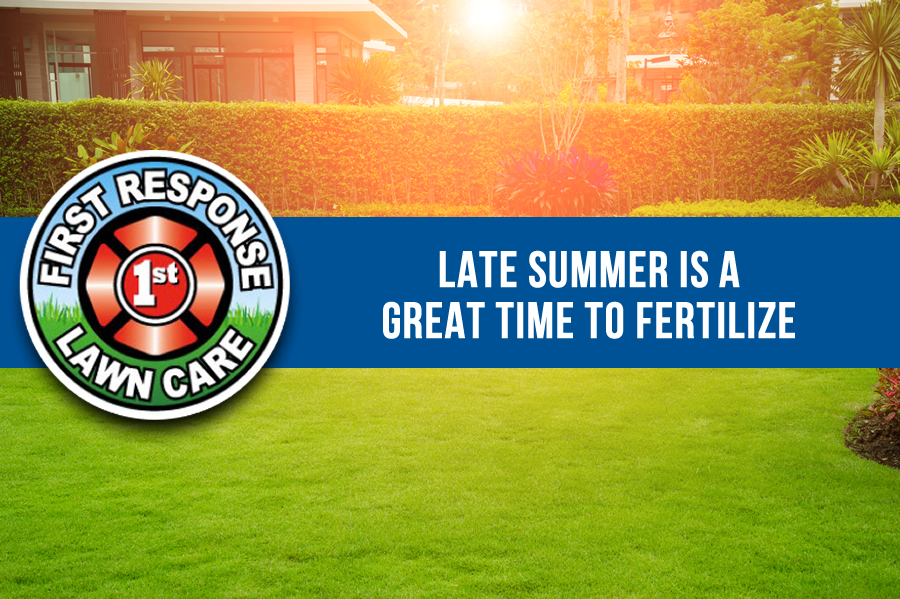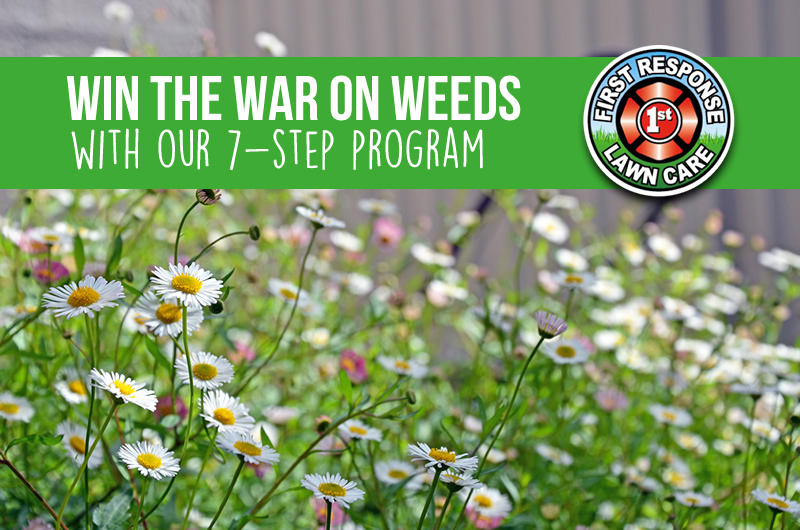
by admin | Sep 24, 2019 | Fertilize Treatments Rockwall, Herbicides
Autumn is the right time of year to nourish your yard!
Fall is here and it’s time to fertilize. Why now? Taking the time to fertilize in the fall will strengthen your plants’ and lawn’s roots, giving them a strong base on which to thrive next spring.
The first thing to understand about fertilizer is the formula, which is represented by three numbers, such as the common 5-10-5. The first number represents nitrogen, which promotes lawn blade and foliage growth; the second number stands for phosphorus, which helps root growth; and the third for potassium, which promotes cell function and absorption of trace elements. But what do you fertilize? When? And with what? Let’s start with your lawn.
During fall, September is the best time to fertilize your lawn. Grass is recovering from a long hot summer and may be coming out of a drought-induced dormancy, so you’ll want to give your lawn a shot of nitrogen to push blade growth. A fertilizer with a formula of 20-8-8 will get it growing again. Always follow the manufacturer’s recommended rate of application. Some people treat weeds and insects at this time, but I think that unless there are signs of trouble or a history of problems, don’t apply anything but fertilizer. While this fall lawn fertilizer dose is important, an application at the end of October or early November is essential. At that time, apply a fertilizer with a formula of 13-25-12. The push of phosphorus will stimulate root growth through November and even into early December. By helping roots grow before winter sets in, you are insuring that the lawn will green-up quicker in the spring and become more resistant to disease and draught.
With the lawn taken care of, it’s time to consider plants. By now, perennials are starting to fade but they will benefit from 0-20-0 super phosphate fertilizer scattered around the plants at recommended doses and lightly cultivated into the soil. Next spring you’ll have stronger plants with more flowers.
Fall is also a great time to fertilize shrubs and trees. Sll trees and shrubs benefit from fertilizer, because most of them are located in mulch beds that use up nitrogen as they decompose. In addition, every fall we rake leaves off these beds, depriving plants of the nutrients that decomposing leaves would traditionally release. To compensate, I recommend applying one to three pounds of slow-release nitrogen per 1,000 square feet of bed and cultivating lightly. (To figure out the exact amount of fertilizer you’ll need, calculate the square footage of your beds and consult with your local garden center.) Fertilizing trees in late September and early October promotes root growth. These nutrients will still be in the soil come spring when plants start to grow. If you have a tree or shrub that does not flower well, a dose of super phosphate will help promote flower growth. However, if the plant is not located in the right spot, all the super hosphate in the world won’t make it flower.
Fall is also the time to plant bulbs. Use super phosphate to promote root growth, insuring strong flowering in the spring. Some people recommend using bone meal when planting bulbs but beware, this attracts rodents who eat both the bone meal and the bulbs.
As you can tell, the basic goal of fall fertilizing is to promote root growth. When you have strong roots, you have healthy plants with numerous flowers. So push those roots!
If all of this sounds complicated and you’d rather leave it to the professionals, call First Response Lawn Care at (214) 701-7622.
We offer a 7 step program to feed and control your lawn weeds.

by admin | Oct 9, 2018 | Herbicides
October and November are important months for your Texas lawn.Most annual winter grasses and weeds that plague lawns in late winter and early spring begin to germinate in September and October.
The best way to stop them in the lawn is to apply a pre-emergence herbicide before the weed seeds start to germinate. Now is a good time to work on this problem as well. Pre-emergent herbicides are chemicals that kill weed seedlings as they germinate. They are not effective once weeds grow beyond the seedling stage. They should be applied according to the label in a uniform broadcast treatment, followed by at least 1/2 inch of rain or irrigation to move the product down to the soil where it is activated.
Post-emergence herbicides are used for weeds which have already begun to show up. You have to be careful with these because most of them can damage St. Augustine grass if temperatures are in the mid to upper 80’s. There is a “window” of time in the fall to catch the broadleaf winter weeds. The earlier you catch them the better. Just watch out for days which are too warm. Also be careful not to get them on desirable flowers, shrubs, etc. They don’t know the difference between a broadleaf weed and a broadleaf ornamental!
Over-seeding is generally not recommended on St. Augustine lawns. It competes with the grass for sunlight, nutrients and water. The additional competition from over-seeding slows spring recovery of the turf. If your turf is stressed or weak already, avoid over-seeding altogether. It will only make the problem worse.
Remember to reduce your watering as temperatures start to cool off over the next few months. Turf will not need the typical 1” per week watering. Excessive water will only be wasted. Reducing or turning off irrigation will not only save water but will reduce your water bill.
If you need help with your pre and post emergent application, call First Response Lawn Care Rockwall today at (214) 701-7622.

by admin | Jul 27, 2018 | Fall Vegetable Garden Prep, Fertilize Treatments Rockwall, Herbicides
August is the time to plant Fall vegetables. Set out transplants of broccoli, cauliflower, and collards. Sow seeds of beets, lettuce, English peas, spinach, turnips, and mustard.
The soil in your garden bed should be loose and easy to work. If it is not, add large amounts of compost or other organic amendments. You can use a tiller or a shovel to work the dirt.
Vegetables don’t have to have their own bed. You can intermingle them among established ornamental plants in your flowerbeds, or grow them in containers. The great thing about using containers is that you can move them at will to catch the proper amount of sunlight.
Vegetables do need lots of sunlight, generally at least six hours of direct sun. Those with edible roots – beets, carrots and radishes – plus broccoli and cauliflower can get by with an hour less sun. And leafy plants such as lettuce or spinach do better with protection from the hot afternoon sun.
Add a slow-release fertilizer if you haven’t fed the bed during the year. If you have, don’t bother. Organic fertilizers such as cottonseed meal work well, though there are plenty of nonorganic fertilizers available. One tip: Before going to the garden center, measure your bed; that way, you’ll know exactly how much to buy, as packages list how many square feet they cover. As always, follow package directions.
Make sure the soil is moist before you plant seeds, as it aids germination. Also, regular watering after you plant is vital to ensure that the August heat doesn’t burn your crop.
Experienced gardeners recommend fertilizing again a few weeks after planting. Just water in the fertilizer around the base of each plant.
Fall will be the time to sow cold-season crops such as lettuce, broccoli, cabbage and cauliflower. Don’t plant seeds of those until early September.
When we reach October, most people will be longing for cool weather. But if you plant tomato transplants now, you’ll be hoping the hot days continue.
•Tomatoes need hot weather to set fruit. Aug. 1 is a bit late to be assured that the fruit has time to mature before first frost, which arrives on average in mid-November.
•Transplants will give you the head start you need.
•Texas AgriLife Extension Service has put together a list of tomato varieties that do well in our area. Don’t expect to find most of them at your local nursery or garden store. Spring is high season for tomato transplants.
•The recommended cultivars: ‘Bingo’, ‘Carnival’, ‘Celebrity’, ‘Sunpride’, ‘Sunchief’, ‘SunLeaper’, ‘Amelia’, ‘Solar Fire’, ‘Florida 47’, ‘Florida 91’, ‘Top Gun’, ‘Porter’, ‘Roma’, ‘Red Cherry’, ‘Yellow Pear’ and ‘BHN444’.
Water can make the difference in whether your vegetable crop succeeds or fails. Too much water – rarely a problem in Texas – can drown plants; too little, and they die.
The most recommended method, both for the plants and for your pocketbook, is to water deeply, but only when needed. Stick your finger into the soil near the plants. If you feel moisture a few inches down, you can wait to water. If dry, water enough to get the soil moist at least 6 inches deep.
The Web site www.learn2grow.com explains five methods of watering vegetables:
Drip irrigation: Delivers precise amounts of water directly to plant roots. Can be time-consuming to set up initially. Saves water costs in the long run.
Trench irrigation: Used when vegetables are planted in rows. Fill a trench that you dig alongside your row vegetables with water. The water will penetrate deeply into the root zone.
Moat irrigation: This close relative of trench irrigation is especially useful when crops are planted on hills. Dig a moat around each plant (square or round) and fill the moat with water when plants need moisture.
Soaker-hose irrigation: Like drip irrigation, soaker hoses deliver water directly to roots. They are not as precise, though they are usually cheaper and easier to lay down.
Overhead misting: Especially for cool-season vegetables. A gentle soaking from a hose-end nozzle allows water to slowly seep in. Time-consuming, though.
First Response Lawn Care can help you with irrigation, fertilization and much more if you need a helping hand with your lawn and garden!

by admin | Aug 25, 2017 | Herbicides, Lawn Care 101, Texas Summer Lawn Care Tips
Hey North Texas, late summer is a great time to fertilize your lawn. Summer is tough on grass. Heat, drought, foot traffic, and insects stress it out to the max. Feeding your lawn in the late summer protects and strengthens it against these problems.
Lawns in warm-season grass areas should be fed over the summer months as they grow steadily from spring to fall. If you see insects in your grass, it’s time to also incorporate insect control.
In the late summer and early fall, root growth begins again because of the decrease in soil temperature and increase in natural rainfall. The grass will green up again with the production of new roots and shoots and damaged patches will start to disappear. Fertilizing at this time will provide the nutrients the grass needs to recover and re-grow rapidly.
The fertilizer you apply in the late summer will be used up by the plant to grow shoots and roots, rather than being stored in plant tissue for use in the future.
Proper fertilization can keep your grass thick and healthy. This helps the lawn resist insects and diseases and makes it harder for weeds to grow. Fertilizers release minerals and nutrients in a “slow release” form. Clients ask us all of the time if it’s too late to make their lawn better and we say it’s never too late with a good routine of weeding, feeding and aerating.
With the fertilization in late Summer, you’ll see improvement in color, growth and health of your lawn.
If you aren’t on a regular schedule to feed your lawn, call First Response Lawn Care today and let’s get started on a plan for your lawn!

by admin | Mar 10, 2017 | Herbicides
Those super pesky patches of unwanted growth that mar your manicured lawn and create an endless series of headaches for you.
Weeds are not only unsighly, but they can have a devastating effect on an entire landscape if they are allowed to spread. Weeds compete with grass for sunlight, water, and essential nutrients robbing your turf. Once they overtake what was once a healthy lawn, it can quickly turn into a wasteland of troublesome weeds.
And when it comes to pre-emergent weed control, timing is everything. Pre-emergent herbicides are only effective if applied before the annual grass weeds emerge. Apply too late and the pre-emergent herbicide will be totally ineffective.
How Pre-Emergent Herbicide Works
To get a better idea of how pre-emergent works, let’s look at 3 key principles of pre-emergent weed control.
#1 Pre-emergent herbicides are designed to control germinating weed seeds.
As its name suggests, pre-emergent is targeted towards weeds that have not yet emerged from the soil. To get the best results and to avoid wasting time and labor cost down the road, the weeds shouldn’t be visible above ground at the time of application.
Important: Pre-emergent is not designed to control existing weeds or weed seeds.
The weed will only be killed when it begins to sprout from the seed and hits the herbicide barrier. It is possible for seeds to remain dormant and not be harmed by the pre-emergent herbicide application. This is why weed control is a constant process. There will always be seeds under the surface and a portion will germinate each season. Annual applications must be made to significantly reduce large infestations.
Remember, pre-emergent herbicide can affect desirable plants. That includes turf. Caution must be taken if you’re applying pre-emergent and seeding the turf in the same season. Seed first, then apply pre-emergent at least 6 weeks later to allow for lawn establishment. Or seed at least 3 months after the pre-emergent has been applied.
#2: Pre-emergent must be mixed correctly and applied evenly over the target area for best results.
Pre-emergent herbicides need to be mixed correctly for the spray solution to be at the appropriate strength. Take the time to read the manufacturer’s recommendations and don’t forget to calibrate your sprayer!
Thorough coverage is key. Think of pre-emergents like a blanket – you need to cover an entire area through which the weed seeds cannot germinate. Spot spraying achieves nothing, as there is plenty of open space for weeds to come through. Manufacturer instructions will indicate how much product to use “per 1000 square feet” or “per acre”, which determines how much herbicide to use for each gallon of water. Note that it usually takes 1 to 2 gallons of spray solution to cover 1000 square feet.
#3: Pre-emergent herbicide must be watered in.
Watering in activates the herbicide, creating a barrier just below the surface. Most products call for 0.5 inches of irrigation or rain within 21 days after application.
If you’re working with a non-irrigated area or a drip zone, apply the pre-emergent just before rain is anticipated.
Applying Pre-Emergent to Different Classifications of Weeds
To know when to apply pre-emergent herbicide, it is important to know how weeds are classified, namely by their life cycles.
Weed Classification: Summer Annuals
Most well-known example: Crabgrass (Crabgrass Germination Map below)
Other examples: Lambsquarters, Mallow, Pigweed, Spurge
Life Cycle: 1 year – Germinate in spring. They flower, produce seed, then die in fall.
Pre-emergent timing: Late winter/early spring
By eliminating the threat of a weed invasion when the weeds are still seeds, you’re literally nipping the problem in the bud. The best way to accomplish this effectively is by implementing a pre-emergent weed control program. First Response Lawn Care offers an efficient 7 step program to feed your lawn and control your weeds.

by admin | Jan 13, 2017 | Herbicides, Lawn Maintenance Rockwall
First Response Lawn Care offers pre-emergent and post-emergent lawn care. If you aren’t familiar with the importance of herbicides, below is a simplified explanation.
Pre-Emergent Herbicides
Pre-emergent type herbicides should be applied when the ground temperatures start rising. Pre-emergents start working before weed seeds germinate and start to grow. Pre-emergents create a seal around the seeds to prevent germination. Essentially, this will suffocate the seeds.
Pre-emergent weedkillers come in either liquid or granular form. Water is required to activate herbicide in granular forms so rain or watering will be needed with this method.
Crabgrass, thistle and other annual weeds that annually sprout from new seeds are treated best through pre-emergent types of weed killers but have little effect on perennial weeds because of their roots.
Post-Emergent Herbicides
Perennial weeds such as Dandelions and White Clover require post-emergent herbicides to combat them effectively. Post-emergent herbicides can be applied in spring once plants have started to grow. Post-emergent weed killers kill weeds after they have started to grow. Direct application to unwanted plants is best for Post-Emergents.
Post-Emergent liquids, spray directly to the weeds to be effective. Granular form work well but, require water to activate the same as Pre-emergents do.
Find out more about First Response Lawn Care’s pre and post-emergent, fertilizer and weed spot services by clicking on the link below.
Our fertilizing program. 7 steps to success






